Key takeaways:
- Pro-life advocacy emphasizes the inherent value of every human life, extending support and compassion to mothers and families rather than solely opposing abortion.
- Door-to-door canvassing fosters personal connections, allowing for meaningful dialogues that can shift perspectives and build understanding.
- Preparation for canvassing involves knowledge, role-playing scenarios, and understanding the audience to tailor communication effectively.
- Overcoming objections is best achieved through active listening, acknowledging concerns, and highlighting the support available for women and families.
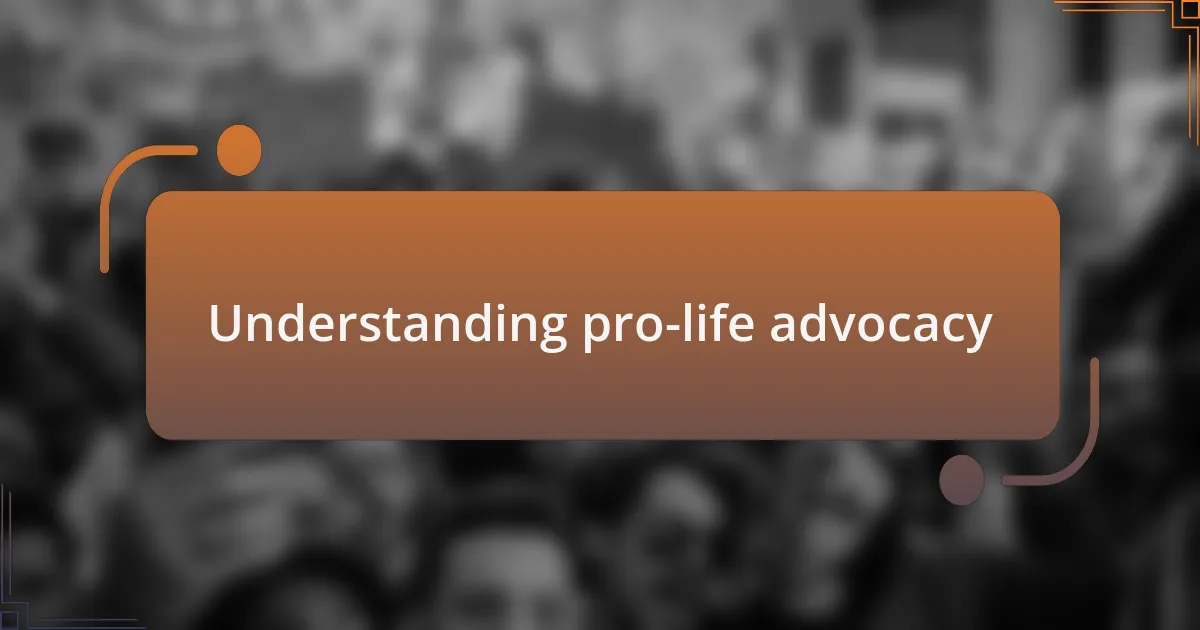
Understanding pro-life advocacy
Pro-life advocacy centers on the belief that every human life, from conception to natural death, has inherent value. I remember my early days of volunteering, grappling with this fundamental idea; it felt powerful yet daunting. Why do we hold certain lives to be more valuable than others, and what does that mean for our society?
Over time, I realized that pro-life advocacy is not just about opposing abortion but also about fostering a culture of life that supports mothers, families, and vulnerable individuals. For instance, during a canvassing event, I spoke with a woman who felt alone in her pregnancy decision. Connecting with her made me appreciate how advocacy extends beyond opinions; it’s about offering compassion and support.
As I interacted with diverse perspectives, I began to see the importance of listening and understanding. I often ask myself, how can we advocate effectively if we don’t truly listen to the stories and struggles of others? This dialogue is crucial, enriching our advocacy with empathy and insight, and reinforcing the belief that every voice matters in this conversation about life.
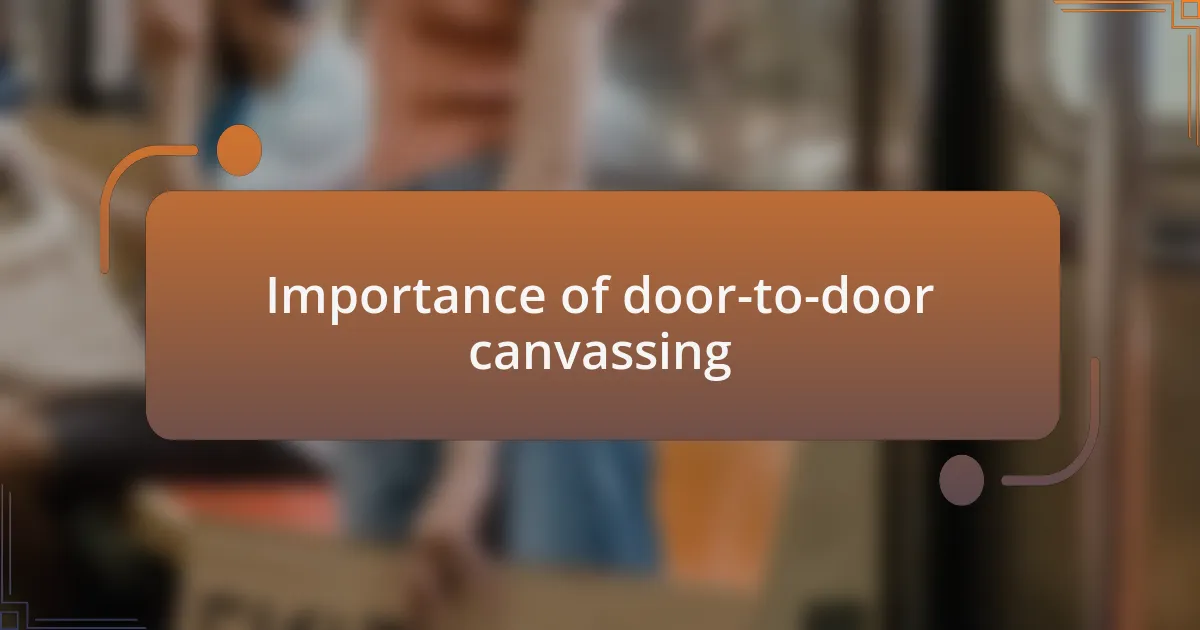
Importance of door-to-door canvassing
Engaging in door-to-door canvassing is vital for pro-life advocacy because it fosters personal connections that social media or phone calls simply can’t replicate. I remember stepping into a neighborhood one sunny afternoon, feeling a mix of excitement and nervousness. Each door that opened was not just an opportunity to share information but a chance to engage in meaningful conversations. How often do we get to hear firsthand the hopes and fears of others? Canvassing allows us to do just that.
When I think back to my canvassing experiences, one encounter stands out—a young couple who initially seemed defensive. Through patient dialogue, we shared stories, and gradually, I witnessed their mindset shift. That moment made me realize the power of face-to-face interaction; it’s a chance to dismantle misconceptions and build bridges of understanding. Isn’t it fascinating how a simple conversation can lead to a deep, new perspective on a complex issue?
Moreover, canvassing provides immediate feedback about the community’s sentiments and concerns. One evening, I spoke with a senior citizen who passionately shared her worries about the younger generation’s attitude toward life. Listening to her helped me see the gaps in our advocacy efforts. It reinforced the idea that our message must resonate with varied demographics to truly make an impact. What better way to strategize than to listen to the voices of those right in our neighborhoods?
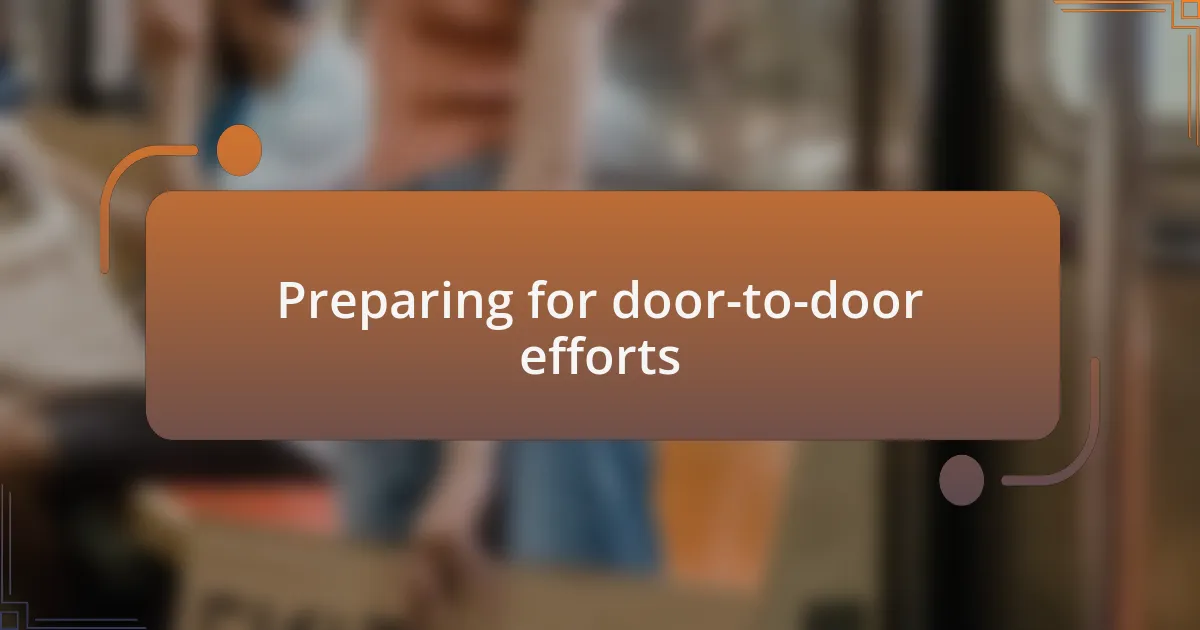
Preparing for door-to-door efforts
Before stepping out into the community, I always made sure to arm myself with knowledge and resources. I would gather pamphlets, statistics, and personal stories that resonated with my own experiences. It’s critical to feel equipped not only with facts but also with the passion that drives us. How can we convey our message effectively if we’re not fully prepared to speak about the complexities of the issue?
Listening is just as important as speaking when you’re preparing for canvassing. During my preparations, I often practiced common scenarios I might encounter at the door. There was one time I role-played difficult conversations with a friend. This practice helped me anticipate challenges and formulate gentle, constructive responses. Isn’t it interesting how rehearsing can build our confidence and ability to connect with others?
Another essential aspect of preparation is understanding your audience. I remember preparing for a day of canvassing in a neighborhood known for its diverse opinions. Researching the community’s demographics inspired me to tailor my approach. By considering their values and background, I felt more connected and aligned with their views during discussions. After all, every person we encounter brings a unique perspective to the conversation, doesn’t it?
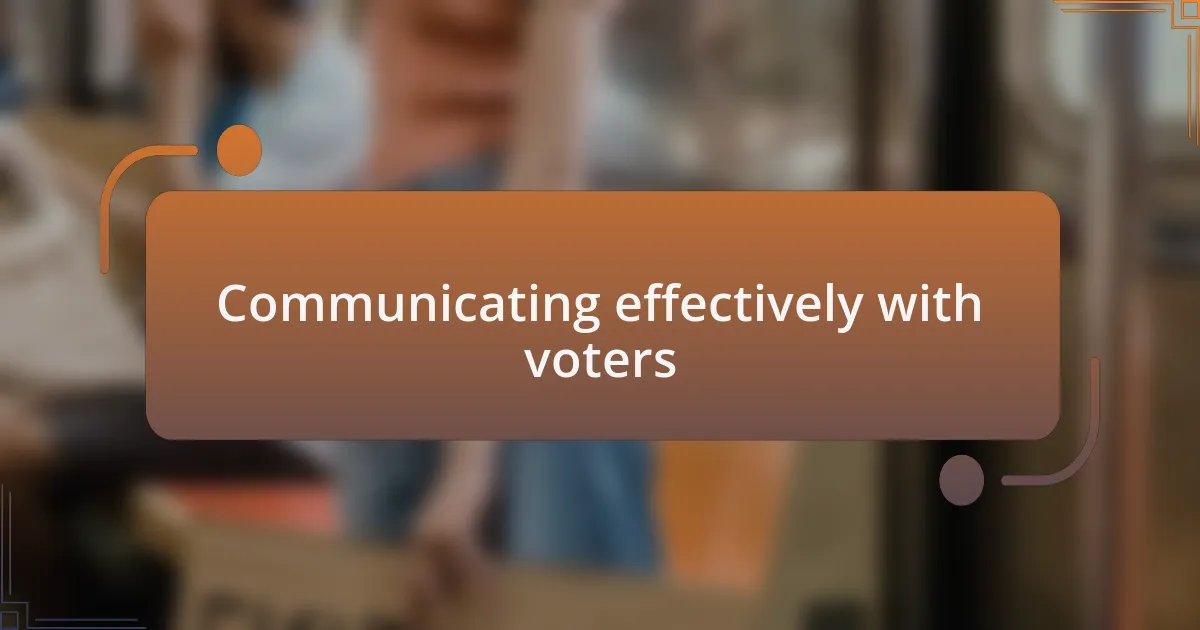
Communicating effectively with voters
When I approach voters at their doors, I focus on establishing a genuine connection right from the start. I often begin with a friendly introduction and a simple question about their day. This not only breaks the ice but also demonstrates that I value their time and opinions. I’ve noticed that people are more willing to engage when they feel heard. Have you ever considered how just a little kindness can change the dynamics of a conversation?
During conversations, I find it crucial to share personal stories that reflect my beliefs rather than overwhelming voters with statistics. One time, a voter shared their experience about their own family struggle with decision-making regarding pregnancy. This opened a heartfelt dialogue where I could share my story about my involvement in pro-life advocacy. Connecting our experiences can evoke empathy and understanding, making the conversation memorable for both parties.
Lastly, I remind myself to adapt my communication style based on the individual I’m speaking with. I once encountered a young couple who were skeptical about my views. Instead of arguing facts, I leaned into their concerns and asked open-ended questions. This not only shifted the focus to a shared exploration of their worries but also allowed me to address their specific concerns thoughtfully. Isn’t it fascinating how a little adaptability can transform a potentially contentious situation into a meaningful exchange?
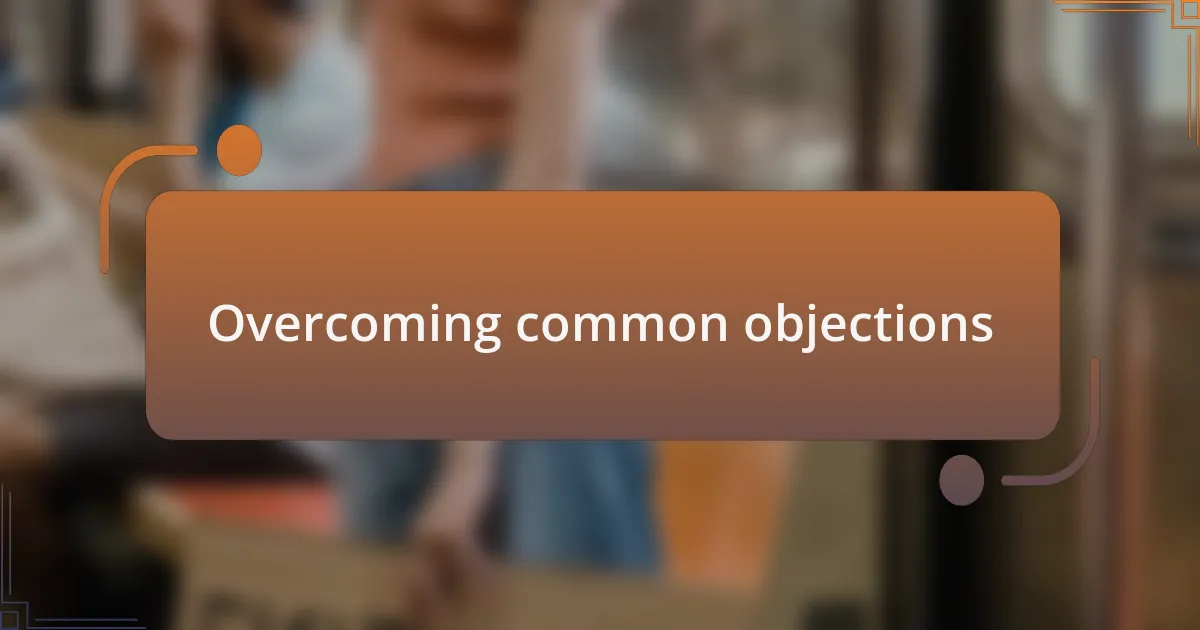
Overcoming common objections
When I encounter objections, I’ve learned the importance of truly listening. For instance, one voter expressed doubts about the potential implications of restricting abortion rights. Instead of dismissing their concern, I took a moment to acknowledge their fears about unplanned pregnancies and emphasized the support systems available for those in need. Isn’t it remarkable how shifting the focus from disagreement to understanding can open the door for further discussion?
Another common objection I face is the belief that pro-life advocates don’t care about women. During one conversation, a woman shared her perception that our movement only valued unborn lives. I gently countered that many of us are deeply invested in women’s health and well-being, citing local resources like pregnancy centers that offer comprehensive support. Reflecting on this, it’s vital to highlight that caring for mothers and children is at the heart of our advocacy, isn’t it?
I’ve also realized that using relatable analogies can help bridge gaps in understanding. In a meeting with a young man who was unsure about the implications of abortion on society, I compared it to the importance of fostering a community that nurtures potential. Just like how we invest in education and housing for families, we should also invest in the lives yet to be born. This approach not only clarified my position but also sparked a deeper conversation about values. Have you ever seen how a simple analogy can illuminate complex issues?
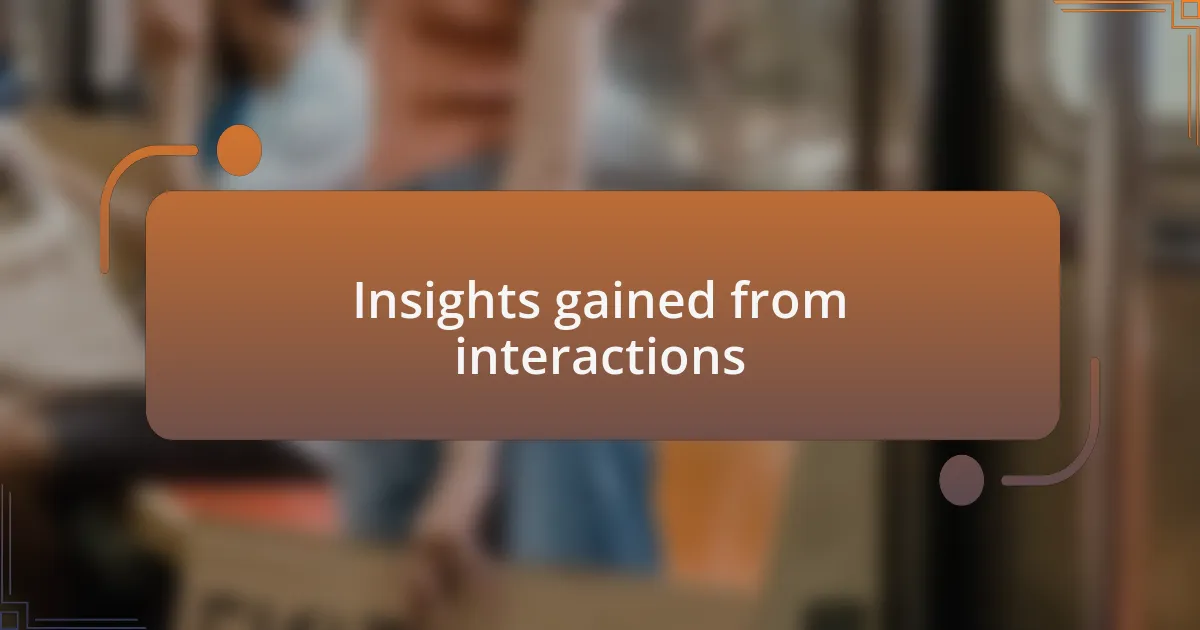
Insights gained from interactions
While canvassing, I’ve found that every interaction holds a chance for genuine connection. One memorable conversation was with an elderly gentleman who shared stories about his daughter facing an unplanned pregnancy many years ago. His vulnerability opened my eyes to the complex emotions surrounding this issue; it reminded me that people’s experiences are often layered with fear and hope. How often do we think about the personal stories behind the statistics?
Another striking insight came from a young woman who expressed confusion about our intentions. Her concerns seemed rooted in a lack of understanding about our goals as pro-life advocates. I shared my own journey—the moments of doubt and learning that led me to this path. It’s interesting to see how personal stories can resonate; sometimes, it’s not just about presenting facts, but about revealing our own humanity that sparks real discussion, isn’t it?
Emotional resonance emerged as a powerful theme in my canvassing experience. I remember one interaction where I spoke with a mother who had chosen adoption for her child. Her face lit up as she recounted the joy of seeing her child thrive with a loving family. That moment reinforced my belief that positivity can often be more persuasive than persuasion itself. How can we show others that choosing life can lead to beautiful outcomes?